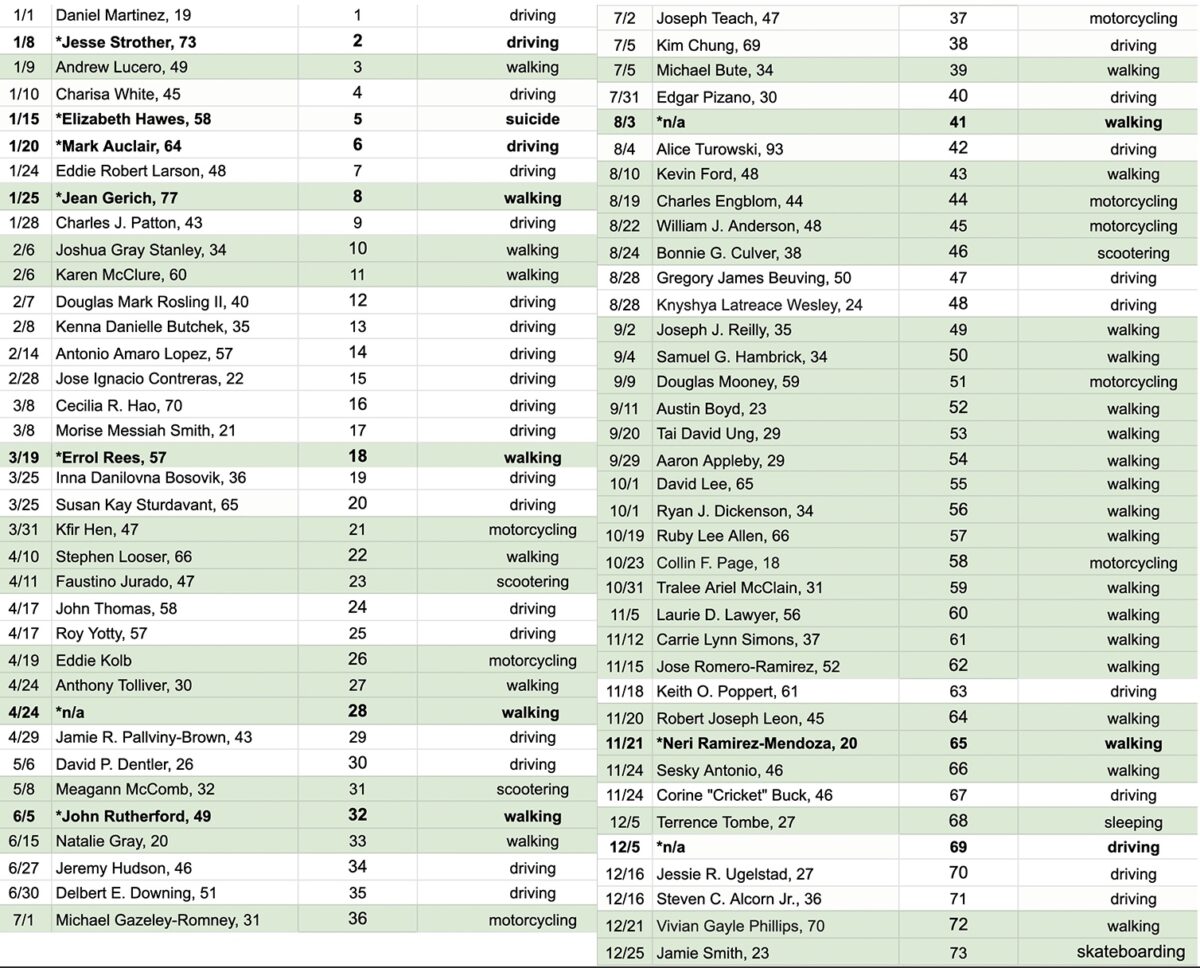
(Taken from BikePortland Fatality Tracker)
Portland’s terrible toll of traffic deaths last year is making a lot of headlines. Unfortunately the news is much worse than many people realize.
Our comprehensive Fatality Tracker lists 73 people for 2021, the 7th highest total since records were kept in 1925.
What Mayor Ted Wheeler referred to as “devastating statistics” don’t paint the full picture of traffic violence in Portland because the official number making the rounds did not include all the deaths caused by motor vehicles. The official tally from the Portland Bureau of Transportation’s report of 63 dead is 10 people short.
Our comprehensive Fatality Tracker lists 73 people for 2021. That’s nearly 1.5 deaths per week for the entire year. By our measure, that would make it the highest total in 34 years and the 7th highest since records were kept in 1925 (according to a list given to me by a source in the Portland Police Bureau).
This year as I updated our list and compared it to PBOT’s report, I was struck at how leaving out these peoples’ deaths is part of a larger problem about how we see (or don’t see) the full scope of what’s really going on. To fully address this crisis, we must embrace the entirety of the problem and I’m afraid the city’s way of accounting doesn’t do that.
This problem is about traffic violence. It’s about how our public and private lives are so overrun with abusive drivers and unsafe, hostile, car-centric spaces that people are under constant threat of violence by their mere existence.
To be clear, PBOT isn’t trying to hide anything. They point out in their report (and it’s not the first time) that their numbers don’t include certain types of fatalities. Portland uses national reporting criteria that doesn’t consider a death to be traffic-related if the person dies more than 30 days after the crash, by suicide or homicide, in a crash that doesn’t involve a motor vehicle (automobile), from “prior medical event” or things like heart attacks, or if it happened in a parking lot. (Note: PBOT says they take all deaths into account when determining project and budg priorities.)
Advertisement
In 2021 we had more of these type of deaths than ever and they should be just as much part of the public, media and political narrative around this issue any other type of tragedy. Why? Because they are very likely a result of the same violent spaces and behaviors that cause the more traditional types of traffic fatalities.
Here are the 10 people not included in PBOT’s 2021 tally, and the reason for their exclusion:
— 73-year-old Jesse Strother crashed his car on SE Powell and 24th after an apparent “medical event”.
— 58-year-old Elizabeth Hawes is believed to have died by suicide after jumping from the NE Halsey overpass onto I-205.
— 64-year-old Mark Auclair was found dead in his vehicle after it crashed into a building on NW Nicolai near NW 25th. “It did not appear there was any other cause of death other than the driver’s medical history,” the official statement read.
— 77-year-old Jean Gerich died when a man intentionally drove his car into her in southeast Portland on January 25th. The man, Paul Rivas, injured nine other people on his rampage and has been charged with multiple counts of murder.
— 57-year-old Errol Rees was the victim of an intentional hit-and-run in Cathedral Park in St. Johns. His killer was charged with attempted murder.
— An unnamed person died after being struck by a MAX light rail operator on N Interstate near Larrabee. (This fatality is the only one we have on our tracker that was not mentioned in PBOT’s report.)
— 49-year-old John Rutherford was killed after being struck by a MAX light rail operator on I-84 near 68th.
— An unnamed person died after being struck by a car driver in the private parking lot of Toyota USA in northeast Portland.
— 20-year-old Neri Ramirez-Mendoza died in a parking lot off of NE 122nd in the Parkrose neighborhood after being struck and left for dead by a car driver.
— 30-year-old Silas High Hawk crashed his car into a power pole in the Cully neighborhood after being shot by someone.
What all these tragic deaths have in common is a built environment dominated by massive steel machines being driven through public spaces often recklessly and even intentionally.
And while PBOT says, “there is no simple or singular solution,” I think they might just be blind to the singular problem: the automobile. The thread running through all but two of these 73 deaths are cars and trucks. Cars and trucks that are so omnipresent in our lives and right-of-way they provide a way to commit suicide, they provide a tool for other types of criminal violence, they can have lethal force even in parking lots, and they can exacerbate a medical problem that someone might very well survive if they weren’t driving one.
Portland is reeling from multiple crises right now. I don’t take any pleasure in writing sad news. But we must be real and honest about the scope and causes of our abusive driving culture, its many enablers, and the traffic violence problem staring us in the face if we want to stand any chance of making it better.

